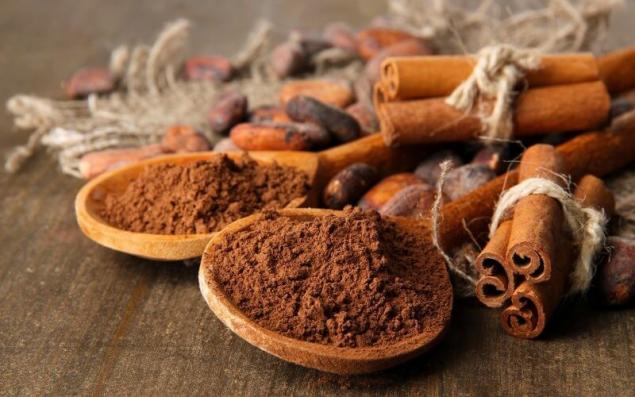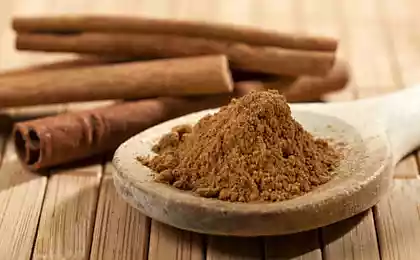515
Cinnamon - the maximum antioxidant effect
Fragrant cinnamon, like ginger discussed earlier, is among the most highly prized spices. Modern science confirms its healing qualities, known for thousands of years.
Cinnamon tree is small and resembles a shrub. Cinnamon is originally from Sri Lanka but also grows in Myanmar, Bangladesh, India, China and Indonesia. It belongs to the family Lauraceae and genus Cinnamomum. There are two main types of cinnamon: Sri Lankan (Ceylon), which is also called "true" cinnamon, it bears the scientific name Cinnamonum verum, and there is also kasiska cinnamon, the most widely used. Kasiska cinnamon is more pungent but less aromatic.
For cooking spice uses cinnamon bark. It is dried and ground into cinnamon powder. Acute taste and smell of cinnamon gives the compound of cinnamic aldehyde. Kasiska cinnamon, also known as Chinese cinnamon, is another member of the family Lauraceae and is the scientific name Cinnamomum cassia.

The benefits of cinnamon for health
The active compounds in cinnamon are known for their antioxidant, antidiabetic, antiseptic, local anesthetic, anti-inflammatory, and irritating (warming and soothing), and carminative qualities.
Cinnamon has the highest antioxidant index of all natural food products. The total antioxidant value (ORAC) of cinnamon is 2,67,536 TE, which is many hundred times higher than, for example, apples.
Consider the spice contains healthy essential oils such as eugenol, belonging to the class of chemical compounds of phenylpropanoids and giving the flavor of sweet cinnamon shade. Eugenol, possessing local anesthetic and antiseptic properties, used in the treatment of teeth and gums.
In cinnamon also contains other essential oil — ethylcinnamate, linalool, cinnamic aldehyde (cinnamaldehyde), beta-caryophyllene, methylchavicol (estragole).
It has been discovered that cinnamic aldehyde has antikoagulyaie properties, preventing the formation of clots in blood vessels, thus preventing stroke, peripheral and coronary arterial disease.
Contained in cinnamon active compounds can enhance the contractility of the intestine, and also help to improve digestion, increasing the production of digestive enzymes.
The spice is also an excellent source of minerals such as potassium, calcium, manganese, iron, zinc and magnesium. Iron is essential for cellular metabolism and as a factor associated with the development of red blood cells. Potassium is an important component fluids of the cells and organism, helps control heart rate and blood pressure. Manganese and copper used by the body primarily as factors related antioxidant enzyme superoxiddismutase.
In appreciable quantities cinnamon also contains vitamin a, Niacin and Pantothenic acid and pyridoxine. She is also a very good source of flavonoid polyphenolic antioxidants — carotenes, zeaxanthin, lutein and cryptoxanthin.
The use of cinnamon in medicine
Essential oil of eugenol used in dental therapy as a local anesthetic and antiseptic in the treatment of teeth and gums.
It was also found that eugenol reduces the diabetics blood sugar level, but to confirm this, more detailed studies.
The cinnamon extract used in traditional medicine to treat flatulence and indigestion.
Considered a spice used in traditional medicines for the prevention of catarrhal diseases and conditions of oxidative stress.
Caution
Unprepared cinnamon can cause asphyxia and respiratory distress syndrome (respiratory failure). Excessive use of cinnamon can cause inflammation of taste buds of the tongue, swollen gums and mouth ulcers. Large amounts of cinnamon can cause difficulty breathing, vasodilation, as well as drowsiness, depression and even seizures.
Nutritional value of cinnamon
In parentheses are the percentage of the daily allowance. Nutritional value is based on 100 grams of cinnamon (Cinnamonum verum) according to information from the Ministry of agriculture of the USA, shown in the resource Nutrition And You.
General information:
energy value — 247 calories (12%);
carbohydrates — 50,59 grams (39%);
protein — 3.99 grams (7%);
fats — 1.24 grams (4.5 percent);
fiber, part of the food and 53.1 grams (133%).
Vitamins:
folic acid (vitamin B9) — 6 micrograms (1,5%);
nicotinic acid (vitamin B3) — 1,332 milligrams (8%);
Pantothenic acid — 0,358 milligrams (7%);
pyridoxine (vitamin B6) — 0,158 mg (12%);
Riboflavin (vitamin B2) — 0.041 mg (3%);
thiamine (vitamin B1) 0.022 milligram (2%);
vitamin a, which very much is contained in dandelion — 295 international units (IU, IU) — 10%;
vitamin C is 3.8 mg (6%);
vitamin E is 10.44 milligrams (70%);
vitamin K, an incredibly rich source of which is sage — 31.2 micrograms (26%).
Electrolytes:
sodium — 10 milligrams (<1%);
potassium 431 mg (9%).
Minerals:
calcium — 1002 milligrams (100%);
copper — 0,339 milligrams (38%);
iron — 8.32 milligrams (104%);
magnesium — 60 milligrams (15%);
manganese — 17466 milligrams (759%);
phosphorus, 64 milligrams (9%);
zinc — 1.83 milligrams (17%).
Phytonutrients:
beta-carotene (ß-carotene), which is rich in carrots — 112 micrograms;
beta-cryptoxanthin (β-cryptoxanthin) is 129 micrograms;
lutein-zeaxanthin — 222 micrograms;
lycopene — 15 micrograms.
Did you know that antioxidant index cinnamon is higher than any other natural food product? published
P. S. And remember, only by changing their consumption — together we change the world! ©
Join us in Facebook , Vkontakte, Odnoklassniki
Source: hi-news.ru/science/biologiya-korica-maksimalnyj-antioksidantnyj-effekt.html
Cinnamon tree is small and resembles a shrub. Cinnamon is originally from Sri Lanka but also grows in Myanmar, Bangladesh, India, China and Indonesia. It belongs to the family Lauraceae and genus Cinnamomum. There are two main types of cinnamon: Sri Lankan (Ceylon), which is also called "true" cinnamon, it bears the scientific name Cinnamonum verum, and there is also kasiska cinnamon, the most widely used. Kasiska cinnamon is more pungent but less aromatic.
For cooking spice uses cinnamon bark. It is dried and ground into cinnamon powder. Acute taste and smell of cinnamon gives the compound of cinnamic aldehyde. Kasiska cinnamon, also known as Chinese cinnamon, is another member of the family Lauraceae and is the scientific name Cinnamomum cassia.

The benefits of cinnamon for health
The active compounds in cinnamon are known for their antioxidant, antidiabetic, antiseptic, local anesthetic, anti-inflammatory, and irritating (warming and soothing), and carminative qualities.
Cinnamon has the highest antioxidant index of all natural food products. The total antioxidant value (ORAC) of cinnamon is 2,67,536 TE, which is many hundred times higher than, for example, apples.
Consider the spice contains healthy essential oils such as eugenol, belonging to the class of chemical compounds of phenylpropanoids and giving the flavor of sweet cinnamon shade. Eugenol, possessing local anesthetic and antiseptic properties, used in the treatment of teeth and gums.
In cinnamon also contains other essential oil — ethylcinnamate, linalool, cinnamic aldehyde (cinnamaldehyde), beta-caryophyllene, methylchavicol (estragole).
It has been discovered that cinnamic aldehyde has antikoagulyaie properties, preventing the formation of clots in blood vessels, thus preventing stroke, peripheral and coronary arterial disease.
Contained in cinnamon active compounds can enhance the contractility of the intestine, and also help to improve digestion, increasing the production of digestive enzymes.
The spice is also an excellent source of minerals such as potassium, calcium, manganese, iron, zinc and magnesium. Iron is essential for cellular metabolism and as a factor associated with the development of red blood cells. Potassium is an important component fluids of the cells and organism, helps control heart rate and blood pressure. Manganese and copper used by the body primarily as factors related antioxidant enzyme superoxiddismutase.
In appreciable quantities cinnamon also contains vitamin a, Niacin and Pantothenic acid and pyridoxine. She is also a very good source of flavonoid polyphenolic antioxidants — carotenes, zeaxanthin, lutein and cryptoxanthin.
The use of cinnamon in medicine
Essential oil of eugenol used in dental therapy as a local anesthetic and antiseptic in the treatment of teeth and gums.
It was also found that eugenol reduces the diabetics blood sugar level, but to confirm this, more detailed studies.
The cinnamon extract used in traditional medicine to treat flatulence and indigestion.
Considered a spice used in traditional medicines for the prevention of catarrhal diseases and conditions of oxidative stress.
Caution
Unprepared cinnamon can cause asphyxia and respiratory distress syndrome (respiratory failure). Excessive use of cinnamon can cause inflammation of taste buds of the tongue, swollen gums and mouth ulcers. Large amounts of cinnamon can cause difficulty breathing, vasodilation, as well as drowsiness, depression and even seizures.
Nutritional value of cinnamon
In parentheses are the percentage of the daily allowance. Nutritional value is based on 100 grams of cinnamon (Cinnamonum verum) according to information from the Ministry of agriculture of the USA, shown in the resource Nutrition And You.
General information:
energy value — 247 calories (12%);
carbohydrates — 50,59 grams (39%);
protein — 3.99 grams (7%);
fats — 1.24 grams (4.5 percent);
fiber, part of the food and 53.1 grams (133%).
Vitamins:
folic acid (vitamin B9) — 6 micrograms (1,5%);
nicotinic acid (vitamin B3) — 1,332 milligrams (8%);
Pantothenic acid — 0,358 milligrams (7%);
pyridoxine (vitamin B6) — 0,158 mg (12%);
Riboflavin (vitamin B2) — 0.041 mg (3%);
thiamine (vitamin B1) 0.022 milligram (2%);
vitamin a, which very much is contained in dandelion — 295 international units (IU, IU) — 10%;
vitamin C is 3.8 mg (6%);
vitamin E is 10.44 milligrams (70%);
vitamin K, an incredibly rich source of which is sage — 31.2 micrograms (26%).
Electrolytes:
sodium — 10 milligrams (<1%);
potassium 431 mg (9%).
Minerals:
calcium — 1002 milligrams (100%);
copper — 0,339 milligrams (38%);
iron — 8.32 milligrams (104%);
magnesium — 60 milligrams (15%);
manganese — 17466 milligrams (759%);
phosphorus, 64 milligrams (9%);
zinc — 1.83 milligrams (17%).
Phytonutrients:
beta-carotene (ß-carotene), which is rich in carrots — 112 micrograms;
beta-cryptoxanthin (β-cryptoxanthin) is 129 micrograms;
lutein-zeaxanthin — 222 micrograms;
lycopene — 15 micrograms.
Did you know that antioxidant index cinnamon is higher than any other natural food product? published
P. S. And remember, only by changing their consumption — together we change the world! ©
Join us in Facebook , Vkontakte, Odnoklassniki
Source: hi-news.ru/science/biologiya-korica-maksimalnyj-antioksidantnyj-effekt.html
Mystical history of Russian cities
Before and After: How an old house in the village is a stylish cottage























